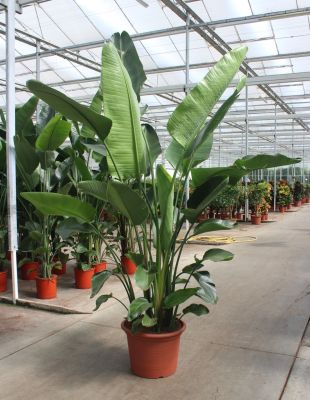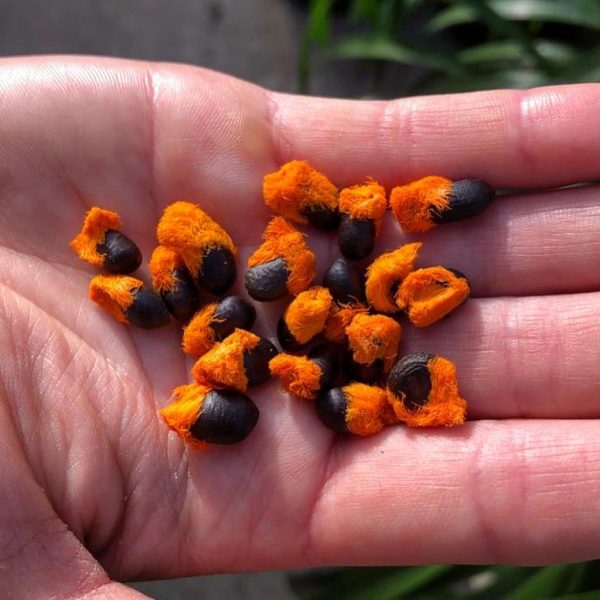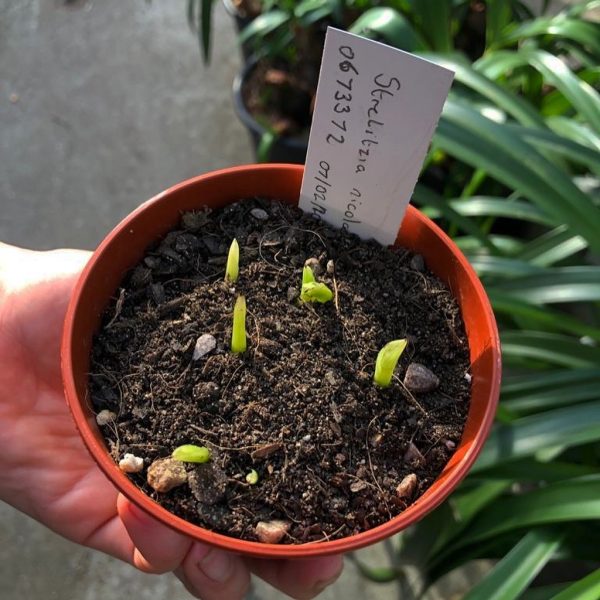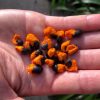Whatapp:
+278.3675.0634
Work Hours
Monday to Friday: 7AM - 7PM
Weekend: 10AM - 5PM






$45.00 – $160.00
Here’s a concise care guide for Strelitzia nicolai (white bird of paradise) as an indoor plant:
Thrives in bright light, ideally direct sunlight near a south-facing window (6+ hours daily). Some sources recommend bright indirect light to avoid leaf scorch, but most agree it tolerates direct sun well when acclimated.
Water thoroughly when the top 1-2 inches of soil dry out. Ensure proper drainage to prevent root rot. Reduce frequency in winter.
Use well-draining mix with coconut coir, perlite, or pumice. Repot every 2-3 years in spring when roots surface, increasing pot size by 20%.
Keep at 18-24°C (65-75°F). Tolerates average humidity but benefits from misting or pebble trays. Avoid cold drafts.
Feed monthly in spring/summer with diluted liquid fertilizer. Worm castings can be added to soil.
Mature plants (6+ years) may produce white/blue flowers indoors with optimal light. Rare in home environments.
Mildly toxic if ingested – keep away from pets. Sap may irritate skin when pruning
Remove dead/damaged leaves at the stem base using clean tools. Wear gloves to avoid sap contact.
Leggy Growth: Indicates insufficient light
Root rot: Caused by overwatering
Leaf splitting : Natural characteristic; increases with age
For best results, prioritize bright light and careful watering. The plant’s dramatic foliage makes it worth the effort.
Signs your Strelitzia Nicolai needs more water include:
-the plant’s foliage looks less perky and more wilted than usual
-the top 1-2 inches of soil feel dry to the touch
-leaves may curl or split due to dehydration
-especially if the dryness is accompanied by dry soil, not just low humidity
-the plant isn’t producing new leaves as expected
Check soil moisture before watering to avoid overwatering. If multiple signs appear together, water thoroughly and monitor recovery
-Yellow Leaves
-Wilting or soft, mushy leaves despite moist soil
-Brown edges on leaves(can also be from other stress, but common with overwatering)
If you notice these signs, let the soil dry out, check for root rot, and adjust your watering routine. Always ensure your pot has drainage and never let the plant sit in standing wate
Yes, you can use a moisture meter to determine the right watering schedule for your Strelitzia Nicolai. A moisture meter gives precise readings of soil moisture, taking the guesswork out of watering and helping you avoid both overwatering and underwatering. Insert the probe deep into the soil near the plant’s base; if the reading is in the 4–5 moisture zone or below, it’s time to water. Always check before watering, as soil dries at different rates depending on season and environmen
Check the soil moisture for your Strelitzia Nicolai at least once a week, and more frequently during warm or dry periods, especially in summer. Use your finger or a moisture meter to test the top 1–2 inches of soil-water only when this layer feels dry. In winter, you can check a bit less often, as the plant needs less water. Regular checking helps prevent both overwatering and underwatering.
Fertilize your Strelitzia Nicolai every 2–4 weeks during the active growing season (spring and summer) using a balanced, water-soluble fertilizer diluted to half strength. In fall and winter, reduce feeding to once a month or stop if the plant’s growth slows significantly. Avoid over-fertilizing, as this can cause leaf burn or stunted growth
Fertilization directly influences the blooming of Strelitzia Nicolai. Regular use of a balanced fertilizer during the growing season supports healthy growth and encourages flower production. Proper nutrient balance is essential-both under-fertilization and over-fertilization can hinder blooming or cause bud drop. For best results, fertilize every 2–3 months in spring to fall with a balanced formula, and avoid excessive feeding to prevent harm to the plant
The optimal fertilization schedule for Strelitzia Nicolai is:
: Fertilize once a month during the active growing season (spring and summer)
: Fertilization is generally not needed unless you want to encourage extra growth or blooming
: Use a balanced formula with equal parts nitrogen, phosphorus, and potassium (such as 10-10-10)
: Reduce fertilizing to once every 3–4 months or stop if growth halts
Always water before and after fertilizing, and avoid over-fertilization to prevent leaf burn or stunted growth
Yes, fertilization schedules for Strelitzia Nicolai can vary depending on the climate where it is grown. In warmer climates with longer growing seasons, you may need to fertilize more frequently-every 2–3 months or even every two weeks during active growth. In cooler climates or during winter, reduce fertilizing to once every 3–4 months or stop altogether, as the plant’s growth slows down. Always adjust your schedule based on the plant’s growth rate and local conditions
Temperature mainly affects how often you should fertilize Strelitzia Nicolai, not the type of fertilizer. In warm temperatures (18–29°C), the plant actively grows and benefits from regular feeding with a balanced fertilizer (equal parts nitrogen, phosphorus, and potassium) every 2–4 weeks during spring and summer. In cooler temperatures or during winter, growth slows, so reduce fertilization frequency and amount to prevent nutrient buildup and root damage. Always avoid fertilizing when the plant is dormant or stressed by cold.
Aim for 60–70% humidity, which is ideal for healthy growth and lush leaves
Use a humidifier to consistently raise humidity, especially in dry seasons or heated homes
Place the pot on a pebble tray with water-as the water evaporates, it increases moisture around the plant
Mist the leaves regularly, particularly during winter or when indoor air is dry
Consider moving the plant to a bright bathroom, where humidity is naturally higher
Monitor humidity with a hygrometer and adjust as needed to avoid levels dropping below 50%, which can cause leaf browning or brittleness
These methods will help keep your Strelitzia Nicolai thriving indoors.
| Sizes | Small, Medium, Big |
|---|
Reviews
There are no reviews yet.